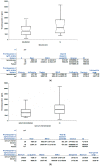Perindopril Induces TSP-1 Expression in Hypertensive Patients with Endothelial Dysfunction in Chronic Treatment
- PMID: 28178210
- PMCID: PMC5343883
- DOI: 10.3390/ijms18020348
Perindopril Induces TSP-1 Expression in Hypertensive Patients with Endothelial Dysfunction in Chronic Treatment
Abstract
Thrombospondin-1 (TSP-1) is a potent endogenous inhibitor of both physiological and pathological angiogenesis, widely studied as a target in drug development for treating cancer. Several studies performed in the cardiovascular field on TSP-1 are contradictory, the role of TSP-1 in the physiopathology of cardiovascular disorders (CVDs) being, for the moment, incompletely understood and may be due to the presence of several domains in its structure which can stimulate many cellular receptors. It has been reported to inhibit NO-mediated signaling and to act on the angiogenesis, tissue perfusion, endothelial cell proliferation, and homeostasis, so we aimed to quantify the effect Perindopril has on TSP-1 plasma levels in hypertensive patients with endothelial dysfunction in comparison with other antihypertensive drugs, such as beta blockers, calcium channel blockers, and diuretics, in a chronic treatment. As a conclusion, patients under treatment with Perindopril had increased plasma levels of TSP-1 compared with other hypertensive patients and with the control group. The results of this study confirms the pleiotropic properties of Perindopril: anti-proliferative, anti-inflammatory, with effects showed by quantifying a single biomarker: TSP-1.
Keywords: TSP-1; angiotensin-converting enzyme (ACE) inhibitors; anti-inflammatory; anti-proliferative; antihypertensive drugs; endothelial dysfunction; essential arterial hypertension; perindopril; thrombospondin-1.
Conflict of interest statement
The authors declare no conflict of interest.
Figures




Similar articles
-
Thrombospondin-1 Serum Levels In Hypertensive Patients With Endothelial Dysfunction After One Year Of Treatment With Perindopril.Drug Des Devel Ther. 2019 Oct 8;13:3515-3526. doi: 10.2147/DDDT.S218428. eCollection 2019. Drug Des Devel Ther. 2019. PMID: 31631975 Free PMC article.
-
Decreased sEng plasma levels in hypertensive patients with endothelial dysfunction under chronic treatment with Perindopril.Drug Des Devel Ther. 2019 Jun 4;13:1915-1925. doi: 10.2147/DDDT.S186378. eCollection 2019. Drug Des Devel Ther. 2019. PMID: 31239642 Free PMC article.
-
Administration of an angiotensin-converting enzyme inhibitor improves vascular function and urinary albumin excretion in low-risk essential hypertensive patients receiving anti-hypertensive treatment with calcium channel blockers. Organ-protecting effects independent of anti-hypertensive effect.Clin Exp Hypertens. 2011;33(4):246-54. doi: 10.3109/10641963.2011.583970. Clin Exp Hypertens. 2011. PMID: 21699451
-
Perindopril.Heart Dis. 2000 Nov-Dec;2(6):446-55. Heart Dis. 2000. PMID: 11728296 Review.
-
[Structural and functional changes of the microcirculation in hypertension: influence of pharmacological therapy].Drugs. 2003;63 Spec No 1:19-29. Drugs. 2003. PMID: 12708883 Review. French.
Cited by
-
Soluble Flt-1 in AMI Patients Serum Inhibits Angiogenesis of Endothelial Progenitor Cells by Suppressing Akt and Erk's Activity.Biology (Basel). 2022 Aug 9;11(8):1194. doi: 10.3390/biology11081194. Biology (Basel). 2022. PMID: 36009821 Free PMC article.
-
Regulation of Cellular Redox Signaling by Matricellular Proteins in Vascular Biology, Immunology, and Cancer.Antioxid Redox Signal. 2017 Oct 20;27(12):874-911. doi: 10.1089/ars.2017.7140. Epub 2017 Sep 8. Antioxid Redox Signal. 2017. PMID: 28712304 Free PMC article.
-
Thrombospondin-1 in maladaptive aging responses: a concept whose time has come.Am J Physiol Cell Physiol. 2020 Jul 1;319(1):C45-C63. doi: 10.1152/ajpcell.00089.2020. Epub 2020 May 6. Am J Physiol Cell Physiol. 2020. PMID: 32374675 Free PMC article. Review.
-
Thrombospondin-1 Serum Levels In Hypertensive Patients With Endothelial Dysfunction After One Year Of Treatment With Perindopril.Drug Des Devel Ther. 2019 Oct 8;13:3515-3526. doi: 10.2147/DDDT.S218428. eCollection 2019. Drug Des Devel Ther. 2019. PMID: 31631975 Free PMC article.
-
Decreased sEng plasma levels in hypertensive patients with endothelial dysfunction under chronic treatment with Perindopril.Drug Des Devel Ther. 2019 Jun 4;13:1915-1925. doi: 10.2147/DDDT.S186378. eCollection 2019. Drug Des Devel Ther. 2019. PMID: 31239642 Free PMC article.
References
MeSH terms
Substances
LinkOut - more resources
Full Text Sources
Other Literature Sources
Medical
Research Materials
Miscellaneous

